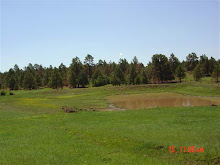11:51 PM CDT on Saturday, June 5, 2010
By Peggy Heinkel-Wolfe / Staff Writer
DISH — Amber Smith no longer takes soaking baths, one of the young mother’s favorite ways to unwind at the end of the day.
Since early May, she and her husband, Damon Smith, and their two children, Hannah, 8, and Bryson, 3, use bottled water to cook with and drink. She has her children use bottled water to brush their teeth.
She said she worries about vapors in the shower mist, and what her family is rubbing into their skin with each short shower they take to clean up.
And she wishes they had taken precautions much sooner.
On Saturday, Damon Smith shows the dirty water filter he changed just five days ago. Smith said his wife, Amber, first noticed the water’s gray appearance last year after a gas well was drilled near the family’s home.
Amber Smith first noticed a gray tinge to the family’s water in March 2009, not long after Devon Energy drilled three new gas wells several hundred feet northwest of their seven-year-old home on Hovenkamp Lane.
“You could see it when you flushed the toilet, or in the bath,” she said.
She complained to her husband, who wasn’t concerned at first — he thought their water well, at 530 feet deep into the slow-moving sands of the Trinity Aquifer, was safe.
Finally, she drew a bath one night and let it settle to show him.
“Amber called me in to see,” Damon Smith said. “You could see it — it looked like gray sand at the bottom of the tub, but when you reached down to touch it, you couldn’t feel anything.”
He went to a home improvement store to buy a filtration system. After finding that he had to change the filter cartridges fairly frequently — about once a month — he bought a crate of them online.
“When I would change them out, it was more of that fine, gray clay, real slimy,” Damon Smith said.
Then, in late April of this year, the Smiths began having major water pressure problems. The gauges on the pump and pressure tank were fine, he said, but when he pulled the filter cartridge, it was caked in a fine, gray sediment. He could see that little water was passing through the filtration system.
He and his father, Dish Town Commissioner Charles Smith, worked all day the first Saturday of May, taking the system apart and cleaning it thoroughly. The plumbing worked fine for about two days, and then the pressure problems began again.
Damon Smith pulled the filter and the cartridge was completely caked again. The Smiths consulted with Mayor Calvin Tillman, who recommended they call a contact at Devon Energy. They told their story to a company representative and urged him to take a filter with him to show his boss, but the representative urged the couple to call the Texas Railroad Commission instead.
A Railroad Commission inspector came out May 5 and took water samples.
Meanwhile, the town of Dish voted to provide for private testing of any area water well that showed a need to be tested. The Smiths signed up and Wolf Eagle Environmental took samples May 13.
At the time, Tillman said town officials had been so focused on emissions coming from a nearby compression complex that they had neglected the possibility that hydraulic fracturing could have compromised well water in the area.
Nationwide, industry officials have said repeatedly that hydraulic fracturing is safe and has been used for years without any documented cases of groundwater contamination. The process was exempted from the Safe Water Drinking Act after a 2004 study by the Environmental Protection Agency deemed it safe.
Recently, that study was discredited and the agency has ordered a new study.
Environmentalists dispute the claim that it’s safe.
“We think they are playing a game of semantics with that statement,” said Amy Mall, spokeswoman for the National Resources Defense Council. The group has chronicled cases in Arkansas, Colorado, New York, Ohio, Pennsylvania, Virginia and Wyoming, and near Grandview, Texas, where water wells appear to have been compromised after a gas well was fracked nearby.
A Railroad Commission inspector called the Smiths a week after the May 5 visit, saying they wanted to come out again. Damon Smith said he pressed them, but the inspector would only tell him that they’d found barium at troubling levels.
“I may be the dumbest guy in the room when you all start talking about these levels,” Damon Smith said, “but when you want to come back out and test some more, I know that’s not good.”
When the family got the commission’s lab results on paper several days after the call, they asked environmental expert Wilma Subra to analyze it, Amber Smith said.
She said Subra’s analysis showed chromium from that sample at 2.5 times the maximum contaminant level, or MCL, established by the EPA; arsenic at 10 times the MCL; and lead at 21 times the MCL.
Barium levels came in not quite half the MCL.
The Smiths were stunned by the report. State health inspectors had been in their home in January, part of the health study being conducted throughout Dish.
A lab report provided to the couple showed state health inspectors had detected benzene, ethylbenzene, styrene, toluene and xylene in their water, but at levels far below federal limits.
The Wolf Eagle samples did not detect the same levels of the heavy metals, but instead found acetone and 2-butanone above the federal limits. Wolf Eagle also tested for total dissolved solids, and found those, too, exceeded federal limits for drinking water.
Railroad Commission inspectors turned around the next battery of tests gathered May 24 in three days, documents show. The lab looked for a larger array of compounds, but did not detect the heavy metals of the May 5 test.
The Smiths said since early May, after they complained to the Devon representative, they’ve not had to change filters as often — maybe every four or five days — but they’ve also questioned whether something had changed at the well. Neither Damon nor Amber — nor Damon’s father, who lives next door — has seen the kind of truck traffic servicing the well in the last month that had been typical up to that point.
Devon Energy spokesman Chip Minty said he did not have any knowledge of the well’s operations, so he could not comment on the family’s observation. He said the company was aware of the complaints about the water well and that the Texas Railroad Commission was investigating the problem, but so far the company had not seen any kind of report.
“It’s too soon to comment,” Minty said.
Ramona Nye, a spokeswoman for the Railroad Commission, did not respond to a request for comment.
The Smiths said they thought the problem would be solved quickly, once the company saw the data. They’ve talked to the EPA, too, and don’t understand what everyone is waiting for.
“We don’t have city water out here,” Amber Smith said. “We don’t have any other options.”
PEGGY HEINKEL-WOLFE can be reached at 940-566-6881. Her e-mail address is pheinkel-wolfe@dentonrc.com.
Clicke here to visit article source






